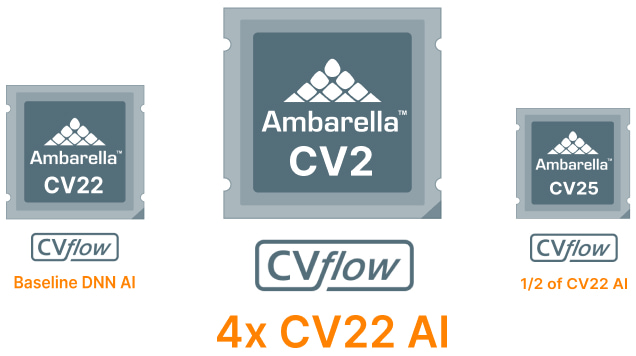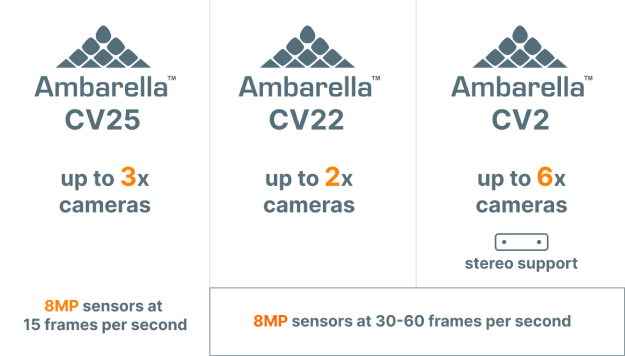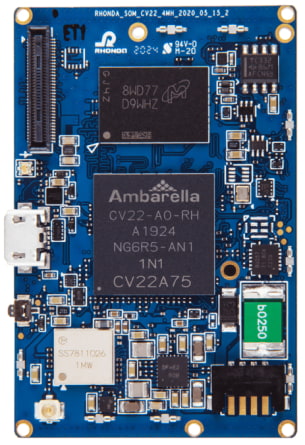All Ambarella CV-series combines chips are good at Video / AI processing and do not require much energy to run an algorithm or multiple algorithms. The differentiation between a good, very good, and incredibly good Ambarella chip can be confusing. So, how to choose an Ambarella CVflow SoC?
There are 3 key qualities of an Ambarella processor:
1. Proven high AI performance
2. Great quality video processing
3. Very low power consumption
AI Processing
Ambarella CVflow is a piece of hardware on each CV chip that is responsible for neural network (NN) acceleration on embedded vision platforms. It was developed to solve the problem of running the latest NNs with minimum effort and high precision. CVflow allows its architecture to scale performance to trillions of operations per second (TOPs) with extremely low power consumption.
In relation to the exact performance of the CVflow AI Processing Engine, Ambarella does not quote TOPs openly like other semiconductor companies. However, it does not mean that it is impossible to address this issue. Ambarella provides good visual guidance on what to expect from the Ambarella CV2, Ambarella CV22, and Ambarella CV25 SoCs. That is how it looks at a high level: the Ambarella CV2 CVflow's performance is generally 4 times more than that of CV22. The CV25 AI performance is half that of CV22's.

Original source: Ambarella. Deutsche Bank Technology Conference
Therefore, the CV2 is the most powerful among these 3 and offers mono and stereo vision support for object detection, classification, tracking and other AI features. As the CV2 has the capacity to run multiple NNs on the edge, the best illustration will be a demo video on YouTube with the person re-identification algorithm, combined with pose estimation and activity recognition.
Based on the comparative illustration above, it is easy to assume that the Ambarella CV25 chip is the least powerful among them. That is so, but it does not eliminate the value of the CV25. It is a capable and reliable processor for when you have in mind to build, for example, a very compact and price-conscious vision system for the automotive aftermarket or the consumer/surveillance industries. To prove this, there is another technology demo video showing how ADAS & DMS are running on a single CV25 chip.
The Ambarella CV22 chip is also a very good fit for running algorithms to support ADAS & DMS without compromising on the camera feature set. Thus, in a whitepaper by Strategy Analytics, a market research firm, the dual AI dashcam (based on the Ambarella CV22) by Motive Technologies was featured for its impressive results in terms of AI and video processing.
The SoC’s image processing is critical to the overall image quality, and the ability to do high-quality video compression also defines both the image quality and bitrate required for video streaming and storage
Video Performance
Let's take a look at the video processing capabilities of Ambarella. As a reference, we'll use the presentation that was delivered by Ambarella at the Deutsche Bank Technology Conference. The CV25 can take up to 3 camera streams and process 8 MP at 15 frames per second. These numbers also mean that a certain trade-off happens between the frames, resolution and the number of cameras. Having 2 cameras with 1 Ambarella CV25 SoC can make camera specs look like 2MP at 60 fps or 4 MP at 30 fps.
Now take the Ambarella CV22, which supports up to 2 cameras with 8MP at 30-60 fps. This time, 2 cameras with one Ambarella CV22 SoC can make camera specs look like dual 4MP 30 fps. Based on this data, it becomes obvious that to get 8 MP at 60 fps video per camera, you require one chip per each image sensor on your camera.
The Ambarella CV2 supports stereo vision and up to 6 cameras with 8MP at 30-60 fps. When you imagine a truck that has a smart surround view system with 6 image sensors, the cameras must split the total resolution and fps between them. For example, you can have 2 cameras running with 4MP at 30 fps and 4 other cameras with 2 MP at 30 fps. It is important to note that the frame rates of having multiple cameras in parallel can vary depending on several conditions and specs.

Original source: Ambarella. Deutsche Bank Technology Conference
Different Ambarella chips have grades, and if you pay attention to the letters and numbers, you can get a rough idea of what to expect from Ambarella's performance. Let us take the Rhonda CV22 SoM that utilizes the Ambarella CV22A75 SoC.
The first 2 letters "CV" refer to the Ambarella CVflow engine. The number "2" represents the AI Processing power, and we explained above what to expect from the CV2 in comparison to the CV22 and the CV25. Next is the letter "A" that stands for "Automotive". It defines the preferred market of operation, other chips can be found with the letter "S", which means "Security". There are other combinations of letters that you can find, such as "AQ" (Automotive Qualified) and "FS" (Functional Safety). The last numbers tell us about the speed grade that can typically vary from 15 to 99. The higher the grade, the better the video encoding and overall computing performance.

Original source: Ambarella-based SoM - Rhonda Software - Camera Design House
Power Efficiency
Power consumption capabilities define how much energy a camera consumes while running video and NNs. Normally, a battery-powered camera with installed computer vision algorithms is expected to be very demanding in wattage. According to the paper by Strategy Analytics, AI dash camera power consumption must not exceed 10 Watts on all camera functionalities, including video, audio and memory. Dissipation for AI processing must be less than 5 Watts (the lower the better) in order to ensure comfortable operation. Ambarella became a top notch provider of silicon that does not require much space on the circuit board to run AI and stay power efficient. This paper creates an impression that you can expect consumption during AI processing on a dual-Ambarella dash cam to be in the 2.5-3 Watt range. The figures will be slightly higher from more complex Ambarella-based solutions.
According to Fermi Wang, CEO at Ambarella, you can expect less than 5 Watt power from the CV2 while simultaneously performing NN processing, image signal processing and HEV's encoding at a 4K resolution. This statement is confirmed by Modar Alaoui, CEO at Eyeris, who said that the Ambarella's CV2AQ SoC is capable of consuming less than 5 Watts while supporting 10 NNs, capturing 30 fps with up to 6 video cameras. Another experiment during CES 2020 Ambarella's demo version showed that the CV2 development board consumed 6.9 Watts while running object recognition workload at 60 fps (16.9 ms inference time).
If you remember, the Ambarella CV2 has extensive NN capabilities. The more algorithms you integrate, the higher wattage you can expect, but in general, power efficiency depends on multiple factors, variables and dependencies. For example, if we take the Ambarella CV22AQ, which is weaker, the wattage can be about 2.5 Watts, because the room for the implementation of an impressive feature set on the CV22 SoC is reduced as well.
Summary
We learned that the performance hierarchy of the CVflow chips looks roughly like this:
CV25 AI < CV22 AI < CV2 AI. You can expect a similar logic in terms of power consumption. The video processing specs depend on each chip's grade. Power consumption will be lower if you add only a few critical AI features to a camera.
This trade-off exists not only for Amarella processors, but for all camera SoCs in terms of balance between AI & Video processing. It can still be challenging to give self-explanatory guidance on how to choose an Ambarella CVflow chip without knowing a camera project's applications, and expert advice is easy to get when you contact a close Ambarella partner who can point Ambarella enthusiasts in the right direction.
References
Ambarella. Deutsche Bank Technology Conference
YouTube. Person re-identification demo on the Ambarella CV2 SoC
YouTube. Ambarella CV25 SoC-based dual camera platform with integrated ADAS & DMS
Ambarella. AI Processors Matter When Selecting Fleet Dashcams
Asmag. Today's camera SoC: More like 'smartness'-on-chip
Rhonda Software. Ambarella-based SoM - Rhonda Software - Camera Design House
Ambarella. Automotive | Ambarella
Ambarella. Security | Ambarella
Motive. Why AI Processors Matter: How to Select the Best AI Dash Cam for Your Fleet
SeekingAlpha. Ambarella Inc. (AMBA) CEO Fermi Wang on Q2 2019 Results - Earnings Call Transcript
EE Times Asia. ADAS: Key Trends on 'Perception'
Self-driving car 360. Ambarella presents the demos CV2, CV22 and CV25 - Self Driving Cars 360
All-electronics. Artificial intelligence in ADAS front cameras (all-electronics.de)

